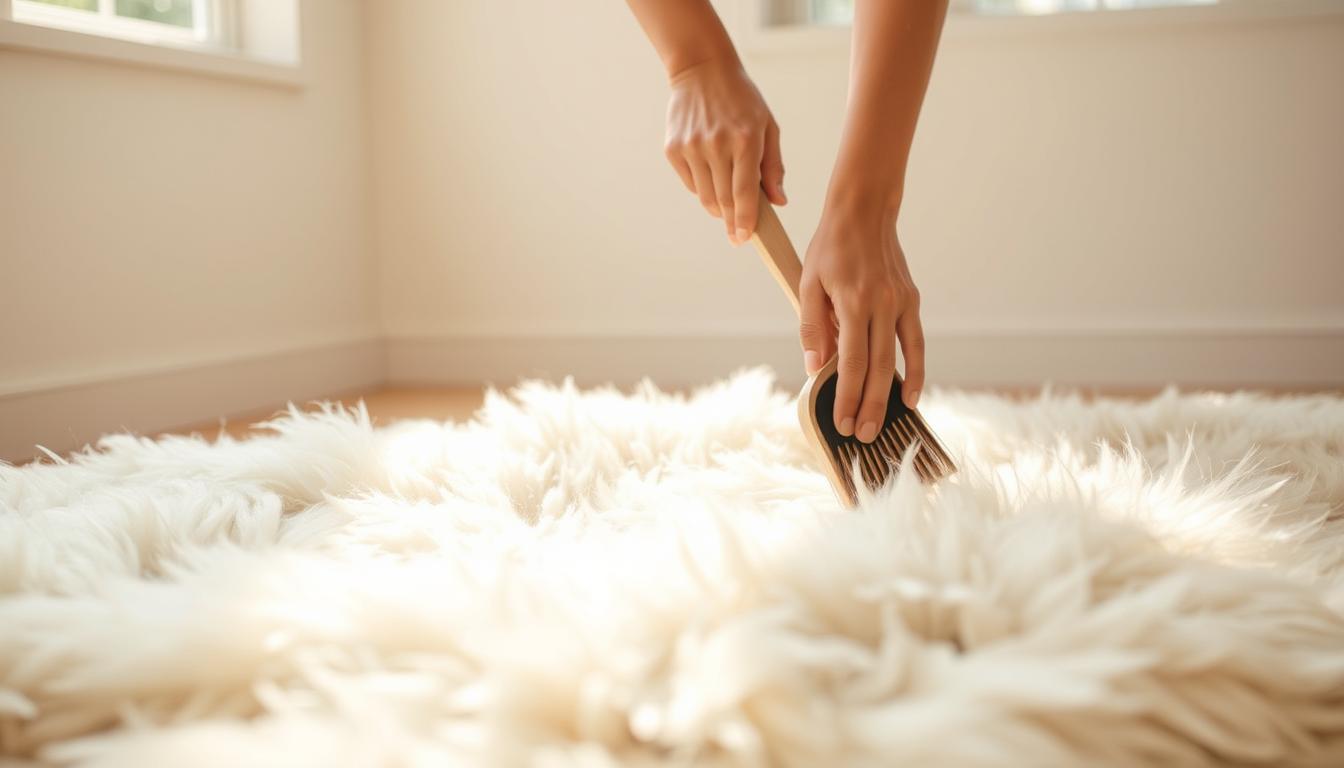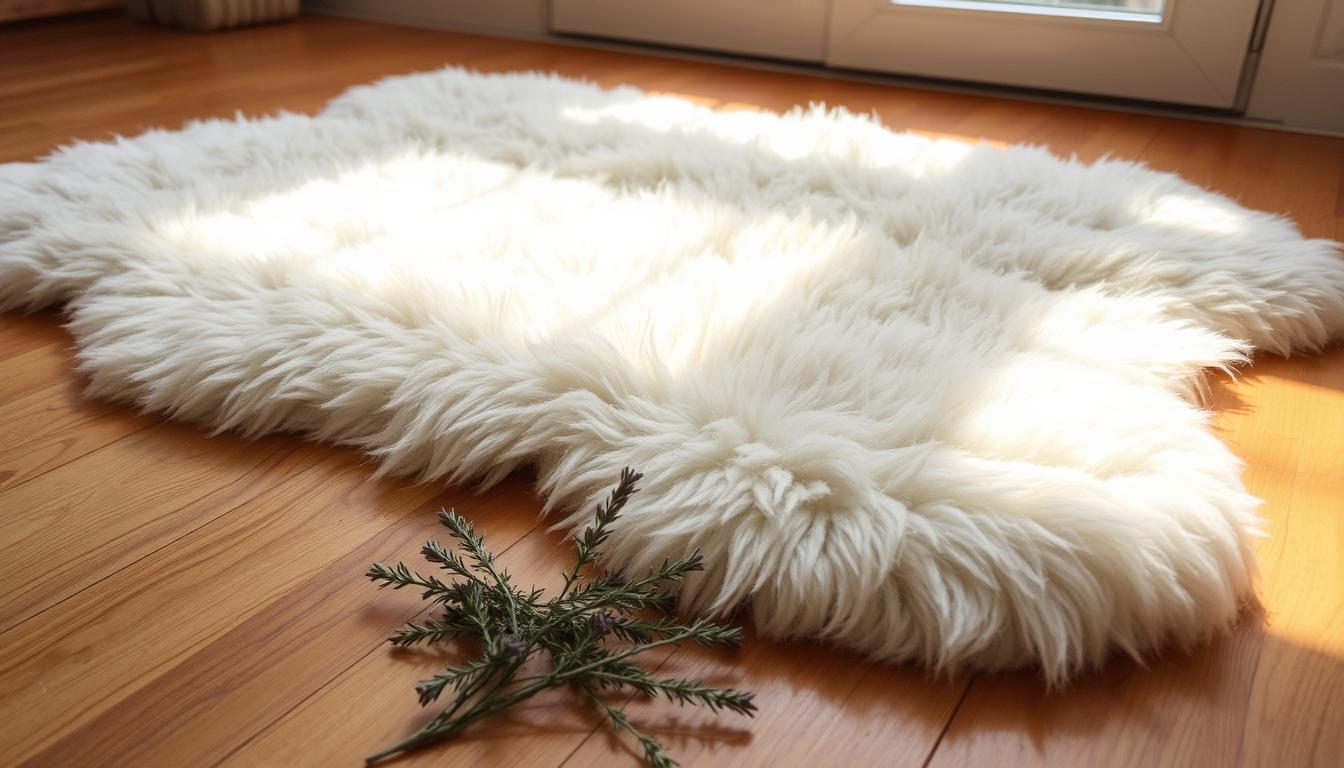
Sheepskin Rug Care: 5 Easy Tips for Lasting Softness
What if your luxurious floor covering could clean itself? Nature already gave wool a hidden superpower—lanolin. This waxy coating on natural fibers repels spills, resists dust, and fights allergens, making maintenance far simpler than most people realize.

You don’t need harsh chemicals or weekly deep cleans to preserve that cloud-like texture. The secret lies in working with your rug’s built-in defenses. For example, gentle vacuuming preserves lanolin instead of stripping it away—a common mistake that leads to premature wear.
Overwashing is another pitfall. Unlike synthetic rugs, these natural treasures thrive with minimal intervention. Our step-by-step cleaning guide shows how to spot-clean stains without damaging delicate fibers. Pair this with proper drying techniques, and you’ll avoid shrinkage or stiffness.
Key Takeaways
- Lanolin naturally repels liquids and dirt, reducing cleaning frequency
- Gentle vacuuming preserves the rug’s protective coating
- Spot cleaning outperforms full washes for most stains
- Air-drying in shade maintains fiber integrity
- Brushing restores fluffiness without chemicals
With the right approach, your investment stays buttery-soft for decades. Ready to unlock methods that turn upkeep into a quick, effortless ritual?
Understanding Sheepskin Rug Care Basics
Your floor’s softest accessory comes with a built-in shield. That cloud-like texture isn’t just cozy—it’s engineered by nature to stay cleaner longer. Mother Nature’s secret? A waxy coating called lanolin that acts like invisible armor.
The Science Behind Self-Cleaning Fibers
Lanolin makes wool naturally slippery, causing spills to bead up instead of soaking in. This biological feature explains why quality pieces resist stains better than synthetic options. One study found untreated wool repels 30% more liquid than processed alternatives.
Smart Cleaning Habits Save Time
Weekly vacuuming with suction-only attachments removes debris without stripping lanolin. Shake your piece outdoors monthly—imagine fluffing a giant pillow to revive its bounce. For spills, press (don’t rub) with a damp cloth immediately. Our guide to ultra-soft wool rugs shows how these methods preserve texture.
Daily vacuuming wears down fibers, while monthly deep cleaning removes too much natural wax. Stick to weekly upkeep—your future self will thank you when that plush feel lasts decades. Simple care lets nature’s engineering do the heavy lifting.
Effective Cleaning Techniques for Your Sheepskin Rug
Ever spilled coffee on your favorite floor accessory? Don’t panic—nature’s fibers handle messes better than you’d expect. The key lies in targeted cleaning that preserves wool’s natural defenses while tackling stains effectively.

Spot Cleaning and Gentle Washing Methods
For fresh spills, hold the affected area under cold water for 1-2 minutes. Gently press—never rub—with a damp cloth to lift stains without matting fibers. This method works for 80% of common accidents, from wine drips to muddy paw prints.
When dealing with stubborn marks, try a cold water rinse mixed with mild detergent. Our cleaning guide shows how to create a foam-free solution that lifts grime without stripping natural oils.
Machine Wash Considerations and When to Avoid It
Suede-backed pieces require professional care—machine washing destroys their delicate structure. Leather-backed options can technically handle washers, but risks remain high. If you must attempt it:
- Use warm water (40°C/104°F)
- Select the gentlest cycle
- Choose non-ionic detergents like Eucalan
Even then, expect potential shrinkage or stiffness. As one textile expert notes: "Machines treat wool like enemy combatants—hand washing always wins."
Preventing Damage from Direct Sunlight and Harsh Chemicals
Always dry your piece in shaded areas—UV rays bleach colors and weaken fibers. Avoid products containing bleach, enzymes, or fabric softeners. These strip away lanolin, leaving wool vulnerable to future stains.
For maintenance between cleanings, shake outdoors monthly and brush weekly with a wide-tooth comb. This preserves fluffiness without exposing fibers to damaging elements.
Sheepskin Rug Care: Keeping Your Rug Soft and Fluffy
Transform your floor covering into a cloud-like retreat with maintenance techniques that enhance its natural resilience. Proper drying and fiber management turn basic upkeep into a texture-preserving ritual.

Restoring Softness with Regular Brushing and Shaking
After washing, lay your piece flat on a clean towel in a shaded outdoor area or ventilated room. Air drying takes 48 hours—rushing with heat sources causes irreversible fiber damage. Once dry, revive stiff leather backing using a wooden stick. "Gentle percussion mimics traditional tanning methods," explains textile conservator Mara Linwood. "It redistributes natural oils for supple flexibility."
Tips to Maintain a Fluffy Wool Appearance
Longer fibers need monthly brushing with a wire pet comb. Work in the wool’s natural direction, lifting strands without pulling. For short-pile versions, weekly vacuuming and outdoor shaking maintain loft. Spot-treat frizzy areas by misting water lightly, then scrunching fibers into shape.
Our cleaning guide details how to air dry properly while preserving texture. Remember: brushing frequency depends on wool length, but patience always beats harsh shortcuts. Treat fibers kindly, and they’ll reward you with enduring softness.
Specialized Care for Different Sheepskin Products
Your favorite cozy accessories need tailored approaches to stay pristine. From car interiors to bedroom essentials, each item demands specific techniques that match its use and material composition.
Caring for Car Seat Covers, Bedding, and More
Auto seat covers thrive when shaken weekly and vacuumed monthly using a soft brush attachment. Blot spills immediately with a dry towel—rubbing pushes liquids deeper. For deeper cleaning:
- Hand wash in cold water with wool-safe detergent
- Rinse until water runs clear to prevent residue buildup
- Lay flat to dry, gently stretching leather backing to original shape
Bedding and mattress covers handle machine washing better than other items. Use the wool/delicate cycle with warm water below 104°F. Tumble dry on air-only settings—never use heat. Reshape while slightly damp to maintain dimensions.
Adapting Methods for Backing Types
Material composition dictates your cleaning strategy. This comparison shows key differences:
| Feature | Leather Backing | Suede Backing |
|---|---|---|
| Cleaning | Hand wash allowed | Dry clean only |
| Drying | Reshape while damp | Avoid moisture |
| Maintenance | Condition annually | Brush weekly |
| Sunlight Exposure | Limited shading | Full shade required |
Shearling gloves and jackets need gentle spot cleaning. Use a damp cloth and suede brush for surface marks. Always dry these items in shaded areas—sunlight causes fading and brittleness. For suede-backed pieces, professional cleaning preserves texture better than home methods.
Conclusion
What if your cozy investment could practically maintain itself? Nature’s genius lies in wool’s hidden ally—lanolin. This natural wax creates a self-protecting barrier, letting you enjoy plush comfort without constant upkeep.
Weekly vacuuming with suction-only tools keeps debris at bay while preserving fibers. When spills happen, grab a clean cloth and blot—never scrub. For stubborn spots, follow our built-in maintenance system guide to avoid damaging delicate strands.
Rotate your piece monthly to ensure even wear, and keep it shaded during drying. Sunlight fades colors and weakens structure over time. Remember: suede-backed items demand professional attention, while leather versions tolerate careful home care.
Trust wool’s innate resilience. With simple habits like shaking outdoors and using gentle maintenance routines, your floor companion stays cloud-soft for years. Nature did the heavy lifting—you just need to work with it.
FAQ
How does natural lanolin protect my wool product?
Lanolin, a wax found in wool fibers, acts as a moisture-resistant barrier. It helps repel dirt and maintains the material’s softness over time. Avoid harsh cleaners that strip this protective layer.
Can I machine-wash my item with a suede or leather backing?
Hand washing is safer for delicate backings. If using a machine, select a cold-water gentle cycle and mild detergent. Always air-dry flat to prevent warping or cracking of the backing material.
Why should I avoid direct sunlight when drying?
Prolonged exposure to UV rays can fade colors and weaken fibers. Dry in a shaded, well-ventilated area to preserve texture and prevent brittleness.
What’s the best way to remove stains without damaging fibers?
Blot spills immediately with a damp cloth and cold water. For stubborn spots, use a wool-safe cleaner. Never rub aggressively—gentle spot cleaning preserves the integrity of the material.
How do I keep car seat covers or bedding fluffy?
Shake them outdoors to lift fibers, then brush gently with a suede brush. Store away from heavy compression to maintain loft. Regular brushing restores the plush appearance.
Are there differences in caring for leather vs. suede backings?
Yes. Leather requires conditioning to prevent drying, while suede benefits from specialized brushes to lift dirt. Always check manufacturer guidelines for compatible products.









